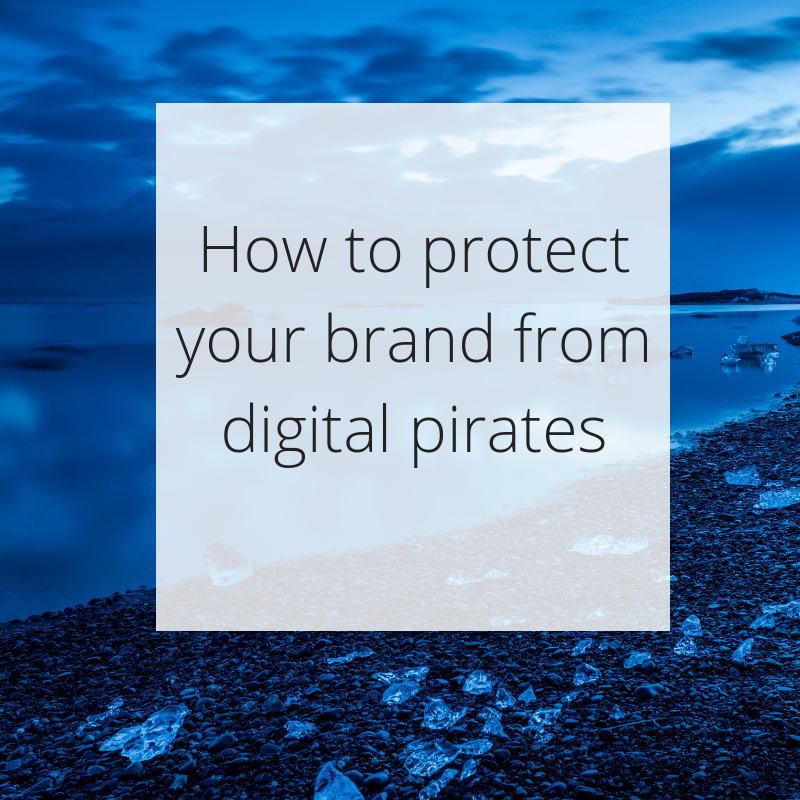
Digital piracy is a real threat to business owners. It’s a threat that’s only growing as we rely more on technology to conduct business.
Digital pirates hijack your good name and wreak as much havoc as they can. This can lead to significant revenue loss, identity theft, and even brand destruction. Yikes!
Fortunately, there are several ways you can protect yourself from spammy swashbucklers vying for your hard-earned brand name.
1. Trademarks, Copyrights, and Patents
You need to legally cover yourself before you put anything online. Period.
If you get stuck in a nasty legal battle with a pirate, you need to have documentation that you have the rights to your brand.
As far as the U.S. Patent and Trademark Office is concerned, if the paperwork isn’t filed, it isn’t yours.
I know filing with the USPTO sounds bureaucratic and boring. After all, you’re running a business. You don’t have time to do things that won’t generate a return.
Fortunately, trademarks, copyrights, and patents are some of the best things you can do to protect your business.
I won’t go into the ins and outs of these nifty filings here, but they’re the first line of defense against brand pirates.
Legal filings give you a leg to stand on if you go to court over who owns your brand. Hey, a digital pirate might not take you that far, but why take the chance? Cover yourself and your intellectual property.
For the most up-to-date information on filing a trademark, copyright, or patent, visit the U.S. Patent and Trademark Office or Copyright.gov for copyrights.

2. Don’t Pay The “Stupid Tax”
When I was 12 I bawled my eyes out because my email got hacked. My dad helped me sort everything out, luckily. But not before he told me I was paying the “stupid tax” for making my password “password.”
Ugh.
My dad had a point, though. It’s easy to be lax about digital security because it’s just not something we think about.
It’s like wearing a helmet when you’re riding a bike. You might get away without a helmet, but you’ll regret not having it once you run over a huge rock.
Digital security is something we take for granted until we don’t have it.
As your business brings in more customers, you can attract the unwanted gaze of digital pirates, longing to take over your site. There’s nothing as nasty as the realization that your site has been hacked and you can’t get it back.
Don’t pay the “stupid tax.”
Create strong passwords and change them frequently (at least once a quarter). Be sure to include combinations of upper- and lowercase letters and numbers.
If you need help generating a strong password, you can try random a password generator.
3. DMCA Takedown Notices
Some digital pirates don’t want to take over your site. Instead, they like to steal your content and parade it as their own. This dilutes your brand and ruins all of the blood, sweat, and tears you’ve poured into your company.
This is where the DMCA (Digital Millennium Copyright Act) comes into play.
The DMCA is a law that governs digital rights management. It was written in the 90s as a way to regulate copyrighted material in the wild, wild west that is the Internet.
The DMCA gives a brand owner the right to take down stolen material on the Internet.
For example, if a digital pirate stole your free eBook and gives it away as their own, you can file a DMCA Takedown Notice on them.
After the DMCA reviews your request, the pirate will receive the DMCA notice. He or she can either comply and remove the material themselves, or if they refuse, their ISP can take the entire site down.
Remember when I said you needed copyright? This is the time to brandish that bad boy. You don’t need to own a copyright to file a DMCA notice, but it does help.
Unfortunately, it isn’t free to file a DMCA Takedown Notice.
But if a digital pirate has stolen your stuff, you’ll probably pay anything to get your brand back.

4. Be Everywhere
It’s much easier to steal something if no one knows it’s missing, right?
That’s why it’s important to monitor your brand day and night. Digital pirates prowl your site and social media looking for opportunities to steal what’s yours.
But hey, we’re all human. We can’t be everywhere all the time. So how do you protect what’s yours without losing your sanity?
I always recommend that my clients create Google Alerts. It’s a good way to know if you earned some unexpected press (yay!) or if someone is stealing your stuff (boo).
Google will send you an email every time content is published containing a keyword that you choose.
So if my business name is Fluffy Panda Studios, I can create a Google Alert for “Fluffy Panda Studios.” I’ll get an email alert any time a story is published using that phrase and I can monitor my brand accordingly.
If you haven’t set up Google Alerts for your business and product names, I highly encourage it.
Another way to be everywhere is to brand everything you put online.
Whether you’re sharing a coupon, free eBook, worksheet, music, etc., make sure your brand is present. It’s much harder for a pirate to say they created a worksheet that has “Fluffy Panda Studios” blazoned on every page.
You don’t have to go overboard here: just make sure your brand is visibly included on all of your materials so there’s no mistake where it came from.
In short, don’t Do Nothing
Whatever you do, take some kind of action to protect your brand. A digital pirate’s best friend is complacency. You work hard to give your best to your customers. Shouldn’t you do the best for your brand?
It doesn’t take a lot of work to protect your business and save yourself numerous headaches. Take these simple steps to ward off digital pirates so you can enjoy the spoils of your hard work.
